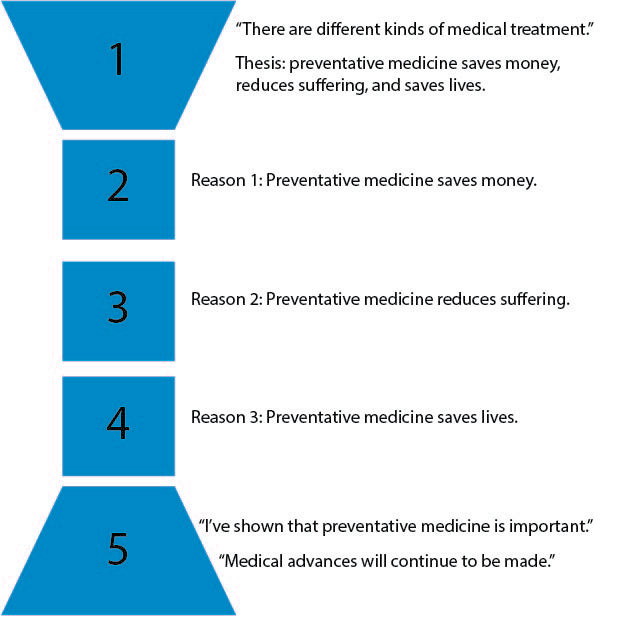3.1: Moving Beyond the Five-paragraph Theme
- Page ID
- 5056
As an instructor, I’ve noted that a number of new (and sometimes not-so-new) students are skilled wordsmiths and generally clear thinkers but are nevertheless stuck in a high-school style of writing. They struggle to let go of certain assumptions about how an academic paper should be. Chapter 1points to the essay portion of the SAT as a representative artifact of the writing skills that K-12 education imparts. Some students who have mastered that form, and enjoyed a lot of success from doing so, assume that college writing is simply more of the same. The skills that go into a very basic kind of essay—often called the five-paragraph theme—are indispensable. If you’re good at the five-paragraph theme, then you’re good at identifying a clear and consistent thesis, arranging cohesive paragraphs, organizing evidence for key points, and situating an argument within a broader context through the intro and conclusion.
In college you need to build on those essential skills. The five-paragraph theme, as such, is bland and formulaic; it doesn’t compel deep thinking. Your professors are looking for a more ambitious and arguable thesis, a nuanced and compelling argument, and real-life evidence for all key points, all in an organically1 structured paper.
Figures 3.1 and 3.2 contrast the standard five-paragraph theme and the organic college paper. The five-paragraph theme, outlined in Figure 3.1 is probably what you’re used to: the introductory paragraph starts broad and gradually narrows to a thesis, which readers expect to find at the very end of that paragraph. In this idealized format, the thesis invokes the magic number of three: three reasons why a statement is true. Each of those reasons is explained and justified in the three body paragraphs, and then the final paragraph restates the thesis before gradually getting broader. This format is easy for readers to follow, and it helps writers organize their points and the evidence that goes with them. That’s why you learned this format.
Figure 3.2, in contrast, represents a paper on the same topic that has the more organic form expected in college. The first key difference is the thesis. Rather than simply positing a number of reasons to think that something is true, it puts forward an arguable statement: one with which a reasonable person might disagree. An arguable thesis gives the paper purpose. It surprises readers and draws them in. You hope your reader thinks, “Huh. Why would they come to that conclusion?” and then feels compelled to read on. The body paragraphs, then, build on one another to carry out this ambitious argument. In the classic five-paragraph theme (Figure 3.1) it hardly matters which of the three reasons you explain first or second. In the more organic structure (Figure 3.2) each paragraph specifically leads to the next.

Figure 3.1 - The five-paragraph “theme”
The last key difference is seen in the conclusion. Because the organic essay is driven by an ambitious, non-obvious argument, the reader comes to the concluding section thinking “OK, I’m convinced by the argument. What do you, author, make of it? Why does it matter?” The conclusion of an organically structured paper has a real job to do. It doesn’t just reiterate the thesis; it explains why the thesis matters.

Figure 3.2 - The organic college paper
The substantial time you spent mastering the five-paragraph form in Figure 3.1 was time well spent; it’s hard to imagine anyone succeeding with the more organic form without the organizational skills and habits of mind inherent in the simpler form. But if you assume that you must adhere rigidly to the simpler form, you’re blunting your intellectual ambition. Your professors will not be impressed by obvious theses, loosely related body paragraphs, and repetitive conclusions. They want you to undertake an ambitious independent analysis, one that will yield a thesis that is somewhat surprising and challenging to explain.


